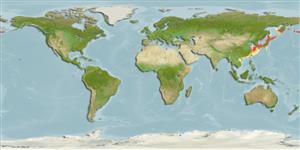>
Perciformes/Cottoidei (Sculpins) >
Agonidae (Poachers) > Agoninae
Eponymy: Dr Harry Wyman Freeman (1923–2012) was Professor of Biology at College of Charleston, his alma mater. [...] Sir D’Arcy Wentworth Thompson (1860–1948) was a Scottish mathematician and biologist. [...] (Ref. 128868), visit book page.
More on authors: Jordan & Gilbert.
Environment: milieu / climate zone / depth range / distribution range
Ecologia
marino demersale; distribuzione batimetrica 10 - 300 m (Ref. 58496). Temperate
Northwest Pacific: Japan to the Sea of Okhotsk and the Sea of Japan.
Size / Peso / Age
Maturity: Lm ? range ? - ? cm
Max length : 22.0 cm TL maschio/sesso non determinato; (Ref. 56557)
Short description
Chiavi di identificazione | Morfologia | Morfometria
Spine dorsali (totale) : 8 - 10; Raggi dorsali molli (totale) : 5 - 7; Spine anali: 0; Raggi anali molli: 6 - 8. Snout projecting forward, with a pair of patches of barbels on its ventral surface. A well-developed strong keel is on the lateral side of the head.
Life cycle and mating behavior
Maturità | Riproduzione | Deposizione | Uova | Fecundity | Larve
Masuda, H., K. Amaoka, C. Araga, T. Uyeno and T. Yoshino, 1984. The fishes of the Japanese Archipelago. Vol. 1. Tokai University Press, Tokyo, Japan. 437 p. (text). (Ref. 559)
IUCN Red List Status (Ref. 130435: Version 2024-2)
Threat to humans
Harmless
Human uses
Strumenti
Special reports
Download XML
Fonti Internet
Estimates based on models
Preferred temperature (Ref.
123201): 0.2 - 13.8, mean 2.4 °C (based on 101 cells).
Phylogenetic diversity index (Ref.
82804): PD
50 = 1.0000 [Uniqueness, from 0.5 = low to 2.0 = high].
Bayesian length-weight: a=0.00389 (0.00180 - 0.00842), b=3.12 (2.94 - 3.30), in cm total length, based on all LWR estimates for this body shape (Ref.
93245).
Trophic level (Ref.
69278): 3.3 ±0.3 se; based on size and trophs of closest relatives
Resilienza (Ref.
120179): Medio, tempo minimo di raddoppiamento della popolazione 1.4 - 4.4 anni (Preliminary K or Fecundity.).
Fishing Vulnerability (Ref.
59153): Low vulnerability (12 of 100).
